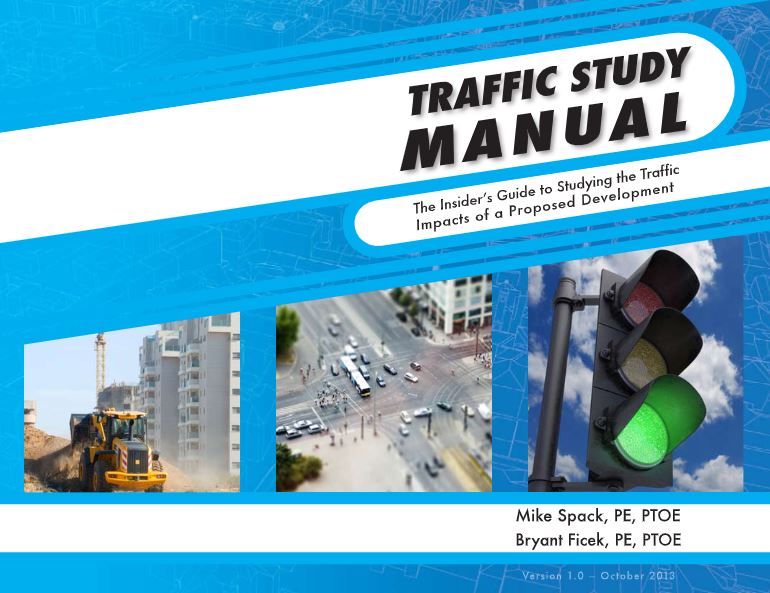
Mike Spack and Bryant Ficek have literally written a book about Traffic Impact Studies and the process from authorization to final study. We present the information we wish we had when starting our careers and hopefully have tips and refreshers that even experienced traffic engineers will find useful. This series presents the basic steps of completing a Traffic Impact Study from their book. See the early posts here.
For every development undergoing a Traffic Impact Study or Travel Demand Management Plan, an important part of the process includes identifying any glaring flaws, from a traffic perspective. Examples could include having an access planned without proper spacing from a traffic signal, having the garbage operations block a drive-thru lane, and intermixing drop-off/pick-up operations with bus activity at a school. These flaws, or red flags, should be readily apparent with a close look at the proposed site plan and could mean significant changes for a developer in order to fix the issue. Identifying and letting the developer know about these red flags early in the process is very important to allow time for potential changes.
We developed a Preliminary Assessment to provide this overview of the proposed site plan as well as other aspects of the project. This one- or three-page document is geared to quickly give a snapshot of the traffic data and potential issues related to a proposed development, whether your client is a developer, the site designer, or a public agency. As mentioned, the reason for our Preliminary Assessment is to bring up potentially disruptive news to our client up front when issues can be addressed more easily than at the submittal deadline. After all, if you wait until after you’ve undergone an entire Traffic Impact Study to deliver the news that a parking lot layout needs to change, you are likely to end up with a pretty upset client who now needs to decide whether to delay the schedule to make a major revision. That can be a deal-breaker for some developments.
In general, we complete our Preliminary Assessment of a proposed development either in conjunction with our Traffic Impact Study proposal, as part of our assumptions to reviewers, or as the next step in our project process (after the assumptions to reviewers). Designed for speed, we can complete our Preliminary Assessment in one to four hours depending on the experience of the person completing the work and the complexity of the development. Here are the basic components:
Introduction: A short paragraph noting the characteristics of the development. In two or three sentences, we provide the location, type, and size of the planned project. We end with a standard statement of purpose – “This technical memorandum presents a preliminary assessment of the proposed development from a traffic standpoint.”
Study Area: This section covers the primary characteristics of the corridors around the site. We put information into a simple table providing each road’s:
- common name
- official designation (like a state highway or county road)
- functional classification
- posted speed limit (or statutory speed limit if not posted)
- number of thru lanes
- whether transit routes exist on the route
- pedestrian/bicycle facilities
We may also note our data collection plan in this section, which usually includes identifying the intersections where we will gather 48-hour turning movement counts. Regular readers know we like two day counts to provide daily volumes and average peak hour volumes to ensure our ‘typical’ weekday is not abnormally high or low.
Estimated Traffic and Parking Generation: Using the latest version of the Institute of Transportation Engineers’ (ITE) Trip Generation Manual and Parking Generation document, providing the daily and peak hour expected traffic along with the expected peak weekday and weekend parking demand. When available, we also provide our local trip generation and parking data for comparison purposes. All information provided is raw, without subtracting for pass-by, internal, or other factors.
Assessment: This section is likely the most important part of the Preliminary Assessment and evaluates several categories. For most assessments, the categories include the following:
- Proposed Access – Is the number of, the location of, and spacing of access appropriate?
- Geometry – Are geometric changes, such as turn lanes, splitter islands, etc. likely necessary with the development?
- Traffic Control – Based on the trip generation, are traffic control changes likely needed (such as changing from two-way to all-way stop control)?
- Multi-Modal Facilities – What opportunities are available for other modes of traffic and does the proposed plan allow for and enhance those opportunities? What is the circulation of pedestrians and bicyclists around the site and to/from the front door?
- Emergency Vehicle/Truck Access – What is the circulation plan for delivery and garbage trucks? Can emergency vehicles easily get to the front doors?
Depending on when we submit our Preliminary Assessment, we can also include a statement about the Traffic Study needs. We want to give the client an idea of the level of detail necessary for their particular situation.
Conclusion: This section is the final component of the document and can vary depending upon when the Preliminary Assessment occurs. Keeping it short and direct, we can re-state the most important points, i.e., the red flags that require site plan changes or noting no red flags are present from the traffic standpoint. We also have a simple disclosure statement that lets our client know the document is not an official engineering report, but just the first step in what we hope will be an on-going conversation.
Although this may sound like a lot of information, and it is, our use of a template with standard tables reduces the completion time. As we stated, the idea of the Preliminary Assessment is to provide a quick overview of the proposed plan. Besides providing the red flag review, we’ve designed the information to be transferable to our Traffic Impact Study or Travel Demand Management Plan. This way, we don’t waste any efforts.
This is a multipart series. Check out the other articles in this series.
- Traffic Impact Study Process – Part 1: Assumptions to Reviewers
- Traffic Impact Study Process – Part 3: Document Existing Conditions
- Traffic Impact Study Process – Part 4: Traffic Data Collection
- Traffic Impact Study Process – Part 5: Prepare Traffic Forecasts
- Traffic Impact Study Process – Part 6: Perform Capacity Analysis
- Traffic Impact Study Process – Part 7: Determine Necessary Improvements

